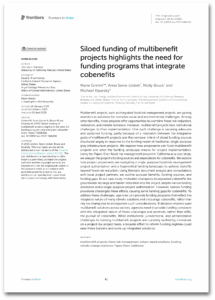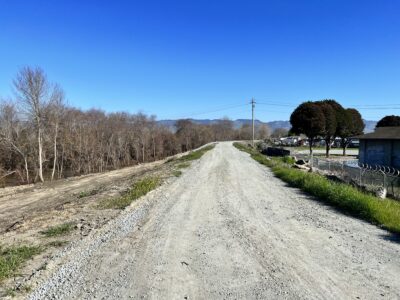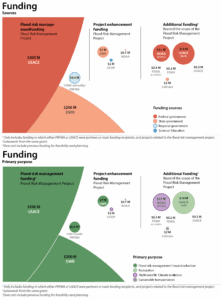We need integrated funding to scale up multibenefit projects
by Marie Grimm, Anna Serra-Llobet, Molly Bruce, and Michael Kiparsky
 Climate and ecological challenges are fundamentally linked, demanding solutions that address both environmental and social issues. Multibenefit projects–like levee realignments that reconnect floodplains–can combine climate adaptation, water management and ecosystem restoration efforts. However, most funding programs focus on single-purpose projects, making it difficult to support multibenefit solutions.
Climate and ecological challenges are fundamentally linked, demanding solutions that address both environmental and social issues. Multibenefit projects–like levee realignments that reconnect floodplains–can combine climate adaptation, water management and ecosystem restoration efforts. However, most funding programs focus on single-purpose projects, making it difficult to support multibenefit solutions.
Our new article studies the Pajaro River flood risk management project in California, exploring how funding can support and hinder multibenefit solutions. We find that local champions were able to integrate multiple benefits into a single-purpose project. However, relying on local innovation is not a general solution to a structural problem. We therefore recommend that agencies and policymakers adapt funding programs to support multibenefit solutions.
The Pajaro River flood risk management project is a valuable example
The lower Pajaro Valley on California’s Central Coast has repeatedly struggled with severe flooding, most recently in 2023. Congress approved an overhaul of the aging levees in 1960, but the project was delayed until 2019 because of cost-benefit concerns and coordination challenges. The $600 million project is funded by the US Army Corps of Engineers and the Pajaro River Flood Risk Management Agency (PRFMA), with the California Department of Water Resources covering PRFMA’s share of the construction costs.
While the main project purpose is flood risk management, champions from PRFMA and the Army Corps saw the opportunity to reconnect floodplains and enable natural processes. They pursued additional benefits like groundwater recharge and habitat restoration, but these benefits fell outside the scope of single-purpose funding sources.


Multibenefit solutions rely on champions
Single-purpose funding provisions, like those of the Pajaro River project, challenge multibenefit solutions: They exclude cobenefits from funding decisions and limit spending to a primary goal, such as flood risk management. Despite these challenges, champions in the Pajaro Valley collaborated to design a levee realignment project that integrates flood protection and ecological benefits. Yet, funding gaps for cobenefits remained.

To extend flood protection and floodplain restoration beyond the project’s core footprint, PRFMA, the Army Corps and partners secured additional funding from more than 10 different grants. This piecemeal funding approach is complex and resource-intensive: Project proponents must navigate multiple grant applications and reporting requirements, while agencies are left with administering multiple programs.
The Pajaro River project demonstrates how champions can break through siloes to advance multibenefit projects. However, it also shows that these projects hinge on individual efforts rather than institutional structures, potentially leaving valuable benefits on the table.
Multibenefit solutions need multibenefit funding programs
The Pajaro River project shows that an integrated flood risk management is possible despite siloed single-purpose funding. However, it also highlights the challenges of funding multibenefit solutions and raises the question: What more could projects achieve if funding programs explicitly supported cobenefits? Integrated funding could facilitate more multibenefit projects, close funding gaps, and ease the burden on project proponents.
We recommend that policymakers and agencies use their respective authorities to modernize funding to reflect the integrated nature of ecosystems and communities. They can support multibenefit solutions by a) creating dedicated single-agency grant programs that fund a project’s full lifecycle and encourage or require multiple benefits; and b) coordinating funding across agencies to produce complementary programs and create joint funding programs for projects that span multiple agency priorities.
We understand that these changes would be significant and non-trivial. At the same time, the transition from traditional limited purpose projects to multibenefit projects has significant and non-trivial positive impacts on social-ecological systems. Policymakers and agencies must consider these options within their own institutional realities.
Institutionalizing cross-sector collaboration is key to addressing climate change impacts and biodiversity loss, and using public resources more efficiently. Multibenefit projects should be the default, not the product of champions. It is time for funding that matches the scale and the complexity of today’s challenges.
Read the full article here or take a look at our website.
——————————————————————————————
This research was funded by the University of California Office of the President (UCOP) Climate Action Seed Grant (ID R02CP7145) and the Agriculture and Food Research Initiative Competitive Grant (No. 2021-69012-35916) from the USDA National Institute of Food and Agriculture.







Reader Comments